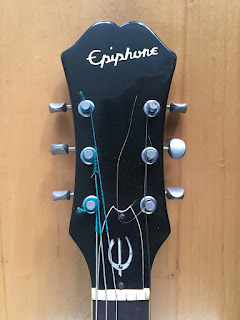I fitted some parts I had left here and there.
lipstick pickups, still great sounding.
Fenix Les Paul Standard copy
A very nice and early example of the Fenix
Les Paul standard copy that between 1989 and
1992 was produced at the Young Chang factory
with the 'near' Gibson headstock and the
mahogany body with maple cap and a
mahogany neck. Same weight as the original.
This picture of the back makes it clear that even the
tuners, that were originally the Kluson tuners, are
carefully copied. A nice piece of mahogany can be
seen here though the cap on the front exist of about
4 parts but nicely done woodwork anyway.
Fretwork and rosewood fingerboard are also
real close to the original. These models can withstand
the comparison with a genuine Tokai Love Rock
though to my believe the electronics in the Tokai are
of a higher quality. The pots are mediocre as are
the pick ups. This guitar deserves better!
The headstock that is close to the Gibson headstock.
The abalone Fenix inlay looks good and the nut and frets
are put in with care! A future collectable! Sold to a pupil
of mine but as it is informative I decided to keep it on
my blog.
Fenix Telecaster TC-20 M
This is a high end Telecaster copy from the Young Chang
factories, made around 1990. Difference between a TC-10
or a TC-20 simply is the bound styled body. The TC-30 is
a Telecaster Thinline model with an F shaped hole. The
addition of the prefix"R" stands for a rosewood fingerboard
This guitar was delivered with gold hardware and had
bindings on front and back. Retailprice around that time
was 795,- in Dutch Florins, about 375 USD. Young Chang
had to change the "Fender" headstock around 1900 / 1991.
The attention to detail is good: A very nice and narrow
neck fit, good fretwork and a neck made out of one piece
of maple and regarding comfort no less than an Americain
made neck. Unbranded Gotoh tuners. The former owner
upgraded the electronics with new pots and a USA pick up
selector switch. He also copper shielded the electronics
cavity. The fingerboard is not an extra maple cap but
the frets have been placed directly into the one piece
maple neck. We've compared this guitar with a later one:
On that guitar also the back was equipped with a birds'
eye maple look as opposed to this example. The three
piece body can be clearly seen. Though I've heard the
figured maple top on some Fenix guitars are coming
from photographical tricks I can't confirm that.
Fenix changed their logo from time to time and besides
their logo, a serial number can be found on the headstock
just above the logo presented here in this picture. Mind you:
It is hardly readable! Here the serial number starts with an
"E" and then 1036854. Maybe produced in 1991? They
also claim the topnut to be bone. The Fenix guitars are
no longer in production: In fact, regarding the Fenix brand,
production stopped in 1994. They are still producing guitars
but now for Paul Reed Smith a.o. The width of the topnut
on this one is 44 mm. The other example measured 425 mm.
As can be seen here closed tuners, most likely
from the Gotoh company. Anyway, good quaity.
A slight mismatch in my opinion is the placing
of the neckplate: A bit too low. Regarding the
body wood, a remark should be made as Young
Chang made cheaper copies for Fender but used
plywood for the bodies in their Squier series at
that time. But mind you! They also produced
the now "iconic" JV Squier series!
The bridge saddles have been upgraded as are the
pick ups. I've had only experiences with the Lace-
sensor look alikes regarding sound. Not bad at all.
The pots and pick up selectors are mostly from
a poorer quality. This guitar has two Seymour
Duncan pick ups fitted now. The top of this guitar
could be a birds eye veneered one but it is also
known that they sometimes photoshopped this
on the front of the body. As birdeye maple often
"disturbes" the lacquer surface, close inspection
learns that it is a least a layer of veneer and not
done with a photographical technique as opposed
with the later Fenix versions of this model.
Though this guitar came with a decent single coil pickup
in the neck position I mounted a mini humbucker with
a coil tap switch in order to make it more versatile.
I've filled the holes that were there for the Bigsby vibrato
arm that was a later addition as well by the former owner.
The holes for the screws have been filled and repainted.





























































